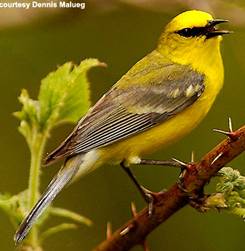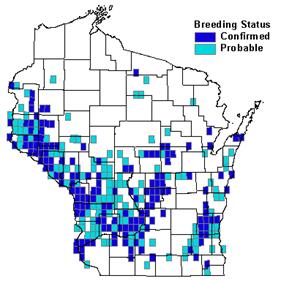Photo by Dennis Malueg


Status/Protection
- Global Rank: G5 Key to global and state ranks
- State Rank: S4B
- WBCI Priority: SGCN, PIF, State Special Concern
Population Information
Federal BBS information can be obtained at http://www.mbr-pwrc.usgs.gov/bbs/bbs.html by clicking on Trend Estimates and selecting the species in question. All estimates are for 1966-2005.
*Note: There are important deficiencies with these data. These results may be compromised by small sample size, low relative abundance on survey route, imprecise trends, and/or missing data. Caution should be used when evaluating this trend.
- Federal Breeding Bird Survey: non-significant decrease
- Federal Breeding Bird Survey (WI): non-significant increase
- Federal Breeding Bird Survey (BCR 23): non-significant increase
- Federal Breeding Bird Survey (BCR 12): significant increase*
- WSO Checklist Project: increasing frequency of reports (1983-2007)
Life History
- Breeding Range: Minnesota south to Oklahoma east to the New England states (Gill et al. 2001).
- Breeding Habitat: Oak, Northern Hardwood, Central Hardwood, Shrub Carr, Aspen, Bottomland Hardwood, Pine Barrens, Grassland-shrub.
- Nest: On or near ground, usually well-concealed by leafy material.
- Nesting Dates: Eggs: mid-May to late June (Robbins 1991).
- Foraging: Foliage gleaner.
- Migrant Status: Neotropical migrant.
- Habitat use during Migration: Similar to nesting habitat, but also some more forested habitats.
- Arrival Dates: Early to late May.
- Departure Dates: By mid-September.
- Winter Range: Southern Mexico and Central America.
- Winter Habitat: Variety of forest, forest edge, and second-growth habitats.
Habitat Selection
The Blue-winged Warbler occupies sites with dense vegetation containing a mixture of young trees, shrubs, and thickets in early- to mid-successional habitats (Gill et al. 2001). Fink et al. (2006) found Blue-winged Warblers to be more abundant in glade habitats than regenerating forests or edge habitats. In this study, glades typically had more grass and forb cover and less woody cover than regenerating forests. In the Baraboo Hills region of Wisconsin, Mossman and Lange (1982) found this species in both large and small forest openings, but not on steep slopes and rocky substrates. Blue-winged Warbler nest sites usually are close to forest edges, and territories may extend into the forest itself. Nests often are placed close to the ground in goldenrod, berry bushes, or clumps of grass, where they are well-concealed by foliage (Gill et al. 2001).
Habitat Availability
The Blue-winged Warbler has expanded its range north and west during the last 60 years (Robbins 1991). It occurs throughout much of the southern half of Wisconsin, including the Baraboo Hills, but is most common in the southwestern quarter of the state (Mossman and Lange 1982, Robbins 1991). An increase in abandoned farms and clear-cutting of the eastern deciduous forests facilitated this range expansion (Gill et al. 2001). However, many of the early successional habitats that this species occupies, particularly oldfields, are disappearing as forest cover expands across previously abandoned farmland (Temple 2006).
Population Concerns
Blue-winged Warbler populations appear stable and widespread (Gill et al. 2001). Breeding Bird Survey data indicate non-significant population increases throughout much of its range (Sauer et al. 2005). During the six-year period (1995-2000) of the Wisconsin Breeding Bird Atlas, observers confirmed breeding activity in 13% of the surveyed quads (Temple 2006). Despite stable population trends, advancing succession and suburban sprawl are threats to this species and other shrubland birds. The loss of mid-successional habitats in the winter range of the Blue-winged Warbler may be an even more significant threat (Gill et al. 2001).
There is concern regarding the hybridization of Blue-winged and Golden-winged Warblers. Prior to the range expansion of the Blue-winged Warbler, contact between the two species in breeding territories was much less common (Gill 1980, Gill et al. 2001). Overwhelmingly, there is more concern over the status of the Golden-winged Warbler, which is less widely distributed and is being displaced by “invading” Blue-winged Warblers.
Recommended Management
Management should focus on conserving large blocks of shrub-successional habitats that contain areas >50-80 m from edges (WDNR 2005, Rodewald and Vitz 2005). Even-aged forest management (e.g., clearcutting) that favors square or circular patches rather than rectangular or irregular ones will increase the interior habitat of clearcuts and benefit many shrubland species (Rodewald and Vitz 2005). Continued management of glade habitats (i.e., controlled burning, mowing, grazing, cedar felling) is important to the conservation of the Blue-winged Warbler and other shrubland birds in the midwestern United States (Fink et al. 2006). Conservation and management strategies for this species should be focused in the following Wisconsin ecological landscapes: Central Sand Hills, Central Sand Plains, Southeast Glacial Plains, and Western Coulee and Ridges (WDNR 2005).
Research Needs
Research is needed to identify ‘source’ habitats for this species within Wisconsin (WDNR 2005). Additional research is needed on the impact of invading Blue-winged Warblers on local populations of Golden-winged Warblers in the state (Gill et al. 2001, WDNR 2005).
Information Sources
- Audubon WatchList: http://audubon2.org/webapp/watchlist/viewSpecies.jsp?id=55
- Chequamegon National Forest Bird Survey (NRRI) species account: http://www.nrri.umn.edu/mnbirds/accounts/BWWAa2.htm
- Nicolet Northern Forest Bird survey map http://www.uwgb.edu/birds/nnf/species/BWWA.htm
- North American Breeding Bird Survey: http://www.npwrc.usgs.gov
- Temple S.A., J.R. Cary, and R. Rolley. 1997. Wisconsin Birds: A Seasonal and Geographical Guide. Wisconsin Society of Ornithology and Wisconsin Department of Natural Resources, Madison, WI.
- Wisconsin Breeding Bird Atlas: http://www.uwgb.edu/birds/wbba/
References
- Coker, D.R., and J.L. Confer. 1990. Brown-headed cowbird parasitism on Golden-winged and Blue-winged Warblers. Wilson Bull. 102: 550-552.
- Confer, J.L. and J.L. Larkin. 1998. Behavioral interactions between Golden-winged and Blue-winged Warblers. The Auk 115:209-214.
- Fink, A.D., F.R. Thompson III, and A.A Tudor. 2006. Songbird use of regenerating forest, glade, and edge habitat types. Journal of Wildlife Management 70(1):180-188.
- Gill, F.B. 1980. Historical aspects of hybridization between Blue-winged and Golden-winged Warblers. Auk 104: 444-449.
- Gill, F.B., R.A. Canterbury, and J.L. Confer. 2001. Blue-winged Warbler. The Birds of North America, No. 584 (A. Poole and F. Gill, eds.). The Birds of North America, Inc., Philadelphia, PA.
- Mossman, M.J., and K.I. Lange. 1982. Breeding birds of the Baraboo Hills, Wisconsin: Their history, distribution and ecology. Wis. Dep. Nat. Resour. and Wis. Soc. Ornithol., Madison.
- Robbins, S.D., Jr. 1991. Wisconsin birdlife: Population and distribution past and present. Madison, WI: Univ. Wisconsin Press.
- Rodewald, A.D. and A.C. Vitz. 2005. Edge- and area-sensitivity of shrubland birds. Journal of Wildlife Management 69(2):681-588.
- Sauer, J.R., J.E. Hines, and J. Fallon. 2005. The North American Breeding Bird Survey, Results and Analysis 1966 - 2005. Version 6.2.2006. USGS Patuxent Wildlife ResearchCenter, Laurel, MD.
- Temple, S.A. 2006. Blue-winged Warbler. In Atlas of the Breeding Birds of Wisconsin. (N.J. Cutright, B.R. Harriman, and R.W. Howe, eds.) The Wisconsin Society for Ornithology, Inc. 602pp.
- Wisconsin Department of Natural Resources (WDNR). 2005. Wisconsin’s Strategy for Wildlife Species of Greatest Conservation Need. Madison, WI.
Contact Information
- Compiler: Tom Klubertanz, tklubert@uwc.edu
- Editor: Kim Kreitinger, K.Kreitinger@gmail.com
